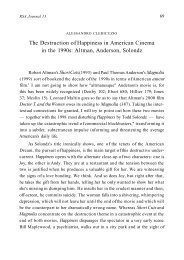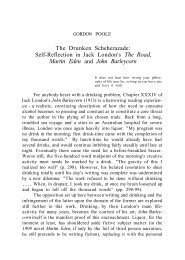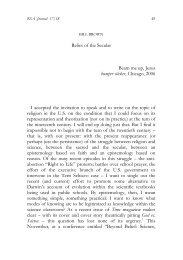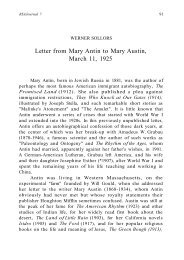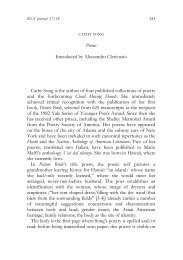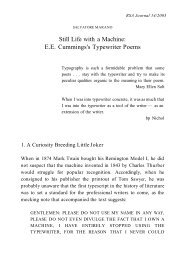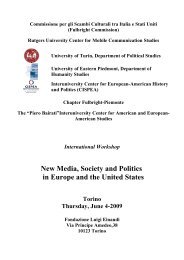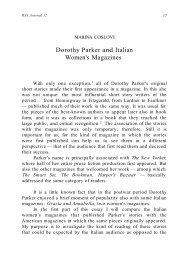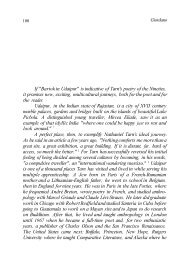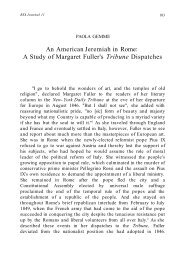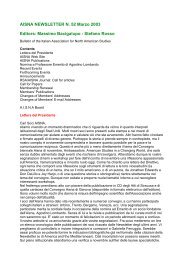Myth and Carnival in Robert Coover's The Public Burning - aisna
Myth and Carnival in Robert Coover's The Public Burning - aisna
Myth and Carnival in Robert Coover's The Public Burning - aisna
- No tags were found...
Create successful ePaper yourself
Turn your PDF publications into a flip-book with our unique Google optimized e-Paper software.
RSA Journal 37fire purifies everyth<strong>in</strong>g... fire separates substances <strong>and</strong> destroys materialimpurities. In other words, that which has gone through the ordeal offire has ga<strong>in</strong>ed <strong>in</strong> homogeneity <strong>and</strong> hence <strong>in</strong> purity. (Bachelard 103-04,author's emphasis)This is undoubtedly the social mean<strong>in</strong>g of the public burn<strong>in</strong>g, asymbolic purification of the social body from its impurities—theoutlaw, the reprobate, the "other." But the holocaust is also, forCoover, the narrative pr<strong>in</strong>ciple susta<strong>in</strong><strong>in</strong>g the classical novel: l<strong>in</strong>earnarrative, unique diegesis, the f<strong>in</strong>al closure lead<strong>in</strong>g to the epiphany ofTruth, all contribute to create a plot that is noth<strong>in</strong>g less than theelim<strong>in</strong>ation of <strong>in</strong>numerable other ways to recount the so-called "mysteries"of existence. In foucaultian terms, the novel, by encompass<strong>in</strong>gthe chaotic material of reality with<strong>in</strong> the pervasive plot of theomniscient author, <strong>in</strong>stitutes a "theater," a "spectacle" for the reaffirmationof social Truth <strong>and</strong> Power. <strong>The</strong> mystery of the classical novel,which epitomizes a society <strong>and</strong> its agents momentarily <strong>in</strong>capable ofmak<strong>in</strong>g sense of the mislead<strong>in</strong>g signs left by the crim<strong>in</strong>al, is f<strong>in</strong>ally"worked out to a solution by a power that no one has charge of. <strong>The</strong>equivocal role of the [narrative closure] is thus a part of a [narrative]strategy whose ideological implications should be pla<strong>in</strong>" (Miller 49). Itis maybe aga<strong>in</strong>st these "ideological implications" that <strong>Coover's</strong> narrativetechnique, by show<strong>in</strong>g that (social) myths <strong>and</strong> truths "are merelyartifices—that is, they are always <strong>in</strong> some way false, or <strong>in</strong>complete"—produces statements which are both aesthetic <strong>and</strong> political (Coover1983, 68).<strong>Coover's</strong> statements, then, are not so much political or literaryassertions as topoi—"commonplaces" where the literary <strong>and</strong> the socialcoexist <strong>in</strong> some sort of metonymic contiguity. <strong>The</strong> essence of thesetopoi is allegory. <strong>The</strong> result<strong>in</strong>g rhetorical complexity is far greater thanmany reviewers of <strong>Coover's</strong> <strong>The</strong> <strong>Public</strong> Burn<strong>in</strong>g have yet allowed. Ityields at the very least an <strong>in</strong>trigu<strong>in</strong>g resonance, a "sympathy" betweenthe real <strong>and</strong> narration, <strong>and</strong> a rich dissonance of implications. Read <strong>in</strong>this context, <strong>Coover's</strong> fiction shows the writer enlarg<strong>in</strong>g his relationshipto the liv<strong>in</strong>g subject by evok<strong>in</strong>g the precise contiguity—albeitsimply rhetorical <strong>and</strong> metonymic—between fiction <strong>and</strong> reality, myth<strong>and</strong> ideology. <strong>The</strong> writer's metafictional efforts are not <strong>in</strong>ert <strong>and</strong>



